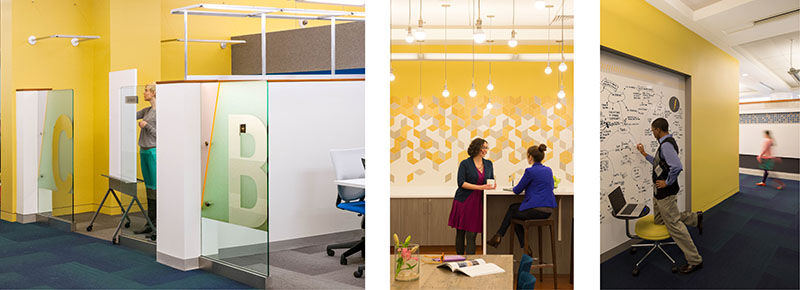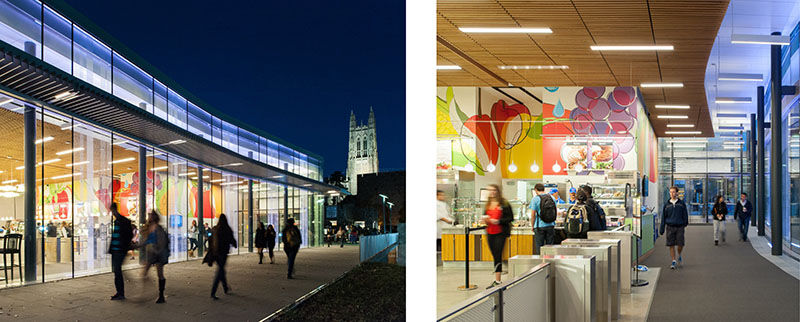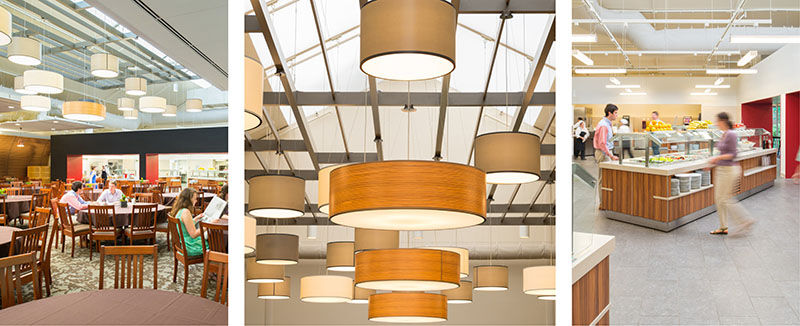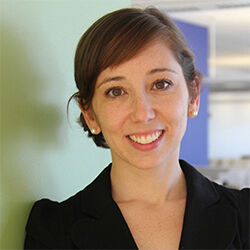
Sara DiNoto, IIDA (MFA IA 2005)

Where are you now and what kind of work/projects are you currently working on?
I am currently an Associate and Senior Interior Designer at Shepley Bulfinch, a 200 person architecture firm with offices in Boston, Houston, and Phoenix. I was first introduced to interior design professionally as an undergraduate student at Northeastern University and was offered a position at Shepley Bulfinch through the school’s co-op program. I rejoined the firm in 2009 following graduate school and several years of designing corporate interiors. My work at Shepley Bulfinch has included a variety of institutional projects mainly for higher education clients.
I truly value being part of a large design team on projects that are making a big impact. My role may be slightly different on each project and has certainly evolved since first starting at the firm. My primary focus is on programming and designing interior spaces for new library, classroom, residence hall and dining facilities. I am currently working on projects for Banner Health in Tucson, AZ, Smith College in Northampton, MA, and North Shore Community College in Lynn, MA. Each project offers a different set of parameters and a different client vision, but a key part of my role is to investigate not only what the client is specifically asking for, but also taking it a step further to what they may not yet see is possible.

How did SAIC prepare you for where you are today? What particular classes/projects/approaches to subjects influenced you?
As a naturally practical person with a very linear approach to problem solving, the idea of going to art school was somewhat uncomfortable for me. I specifically chose to study at SAIC because I believed it would force me to move my thinking forward, learn to look at questions in a different way, and find a way to accept that discomfort and make it productive. One of the best things about the program was the support for cross-disciplinary learning which encouraged me to take classes outside of my department. The knowledge I gained within the department, but also from classes in ceramics, historic preservation, and fashion design, expanded my view and gave me the confidence to continue to look outside of our industry for new inspiration.
In almost every class I took, the professors gave me space to push on the abstraction of an idea, but then expected me to find a way to make that idea something I could share with others, which for me was typically through a physical item or expression of items. The message that I heard was not just to sketch, conceptualize and talk, but rather to get something made. It didn’t always work out the way I expected, and sometimes I started making something and ended up with what felt like a bunch of nothing – and I suppose, that was where the real work started!
The culmination, for me, was an installation, led by HM Nugent and Doug Pancoast, for ICFF 2005. The entire process of taking multiple visions, stringing them together into a collective plan, pushing against the realities of getting things produced, built, broken down, shipped (i.e. driven by 3 wily students) to NYC and then set back up, was capped in that amazing moment when we saw the reaction of visitors to our booth. The exhilaration of watching people feel joy or awe in reaction to a space or an object that I worked to create is what I seek.

What career advice do you have for current students, looking at how you see your field evolving, what is critical for the future practitioner?
My advice to students is to be honest with yourself about what you want to get out of the program and then allow yourself to be uncomfortable, because that is probably when you are learning the most. Everyone has things that they are naturally better at than others, and being a student is one of the best times to explore those that push you beyond your boundaries. The increasingly interdisciplinary nature of this industry, and constantly changing technologies, means you have to be nimble and aware so that you can bring the latest advances to your projects. Your future clients are trying to stay on the cutting edge and it will be important for you to be able to push them beyond what may be their comfort zone.
With whom did you study at SAIC or who influenced you?
SAIC was the only school I applied to. I prioritized being in an urban center and, of course, Chicago has amazing architecture, so that context was a big influence. Looking back, more than 11 years later, I continue to fall back on skills and knowledge fostered by a class I took with HM Nugent focused on designing with light (not just light fixtures) where we studied the dramatic impact of light and shadow. I remember the energy of Carl Ray Miller, who I also TA’d for one semester, intent on getting us to stop talking about an idea, AND JUST MAKE IT! I also still benefit from the steady influence of Doug Pancoast as I developed a path to work through each new design problem. For me, my two years in Chicago at SAIC were important growth years, and I was exposed to a whole range of methods, materials and ideas that have continued to be influential to my career development.

Sara DiNoto is a senior interior designer and an Associate with Shepley Bulfinch, a national architecture firm known for design excellence and innovation. With offices in Boston, Houston, and Phoenix, the firm provides architecture, planning, and interior design solutions for leading institutions in academics and healthcare, as well as urban development and civic organizations.
For close to 15 years, Sara has worked with clients to create collaborative environments, using furnishings and interior architecture to design spaces that flex to support group study and individual scholarship. Her work for higher education clients has included academic and social spaces for Duke University, Johns Hopkins University, and Harvard Business School. Her current work includes projects for Banner Health, Smith College and North Shore Community College. Sara holds a Master of Fine Arts degree in Interior Architecture from the School of the Art Institute of Chicago (SAIC), and a Bachelor of Science degree in Architecture from Northeastern University.
